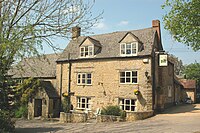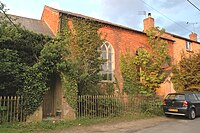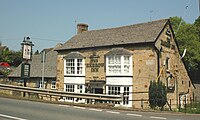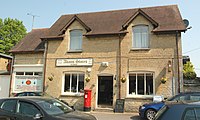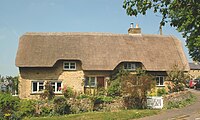Enstone
| Enstone | |
| Oxfordshire | |
|---|---|
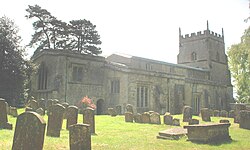 St Kenelm's parish church, Church Enstone | |
| Location | |
| Grid reference: | SP373246 |
| Location: | 51°55’10"N, 1°27’29"W |
| Data | |
| Population: | 1,139 (2011, with hamets) |
| Post town: | Chipping Norton |
| Postcode: | OX7 |
| Dialling code: | 01608 |
| Local Government | |
| Council: | West Oxfordshire |
| Parliamentary constituency: |
Witney |
| Website: | enstoneparish.org |
Enstone is a village in the Cotswold Hills in the west of Oxfordshire, about four miles east of Chipping Norton and fifteen miles north-west of the county town, Oxford.
The wider civil parish also encompasses a neighbouring village, Neat Enstone, and such hamlets as Chalford, Cleveley, Fulwell, Gagingwell, Lidstone and Radford: the 2011 Census recorded this parish's population as 1,139, in 453 households.
Enstone is at the junction of two long-established main roads, one between Oxford and Chipping Norton and the other between Enstone and Bicester. Both were once turnpikes: the Act of Parliament for the latter was passed in 1797. Since the 1920s, the Oxford–Chipping Norton road has been numbered the A44 and the Enstone–Bicester Road the B4030.
Contents
Name
Enstone takes its name from a standing stone called the Ent Stone, part of the ruins of a Neolithic tomb just off Charlbury Road. Enta is an Old English world for a giant. The feature, also known as the Hoar Stone,[1] is a scheduled ancient monument.[2]
Churches
Church of England
The earliest parts of the parish church, St Kenelm, are Norman, but it has been rebuilt in stages since the 12th century. The south aisle with a four-bay arcade dates from about 1180. The north aisle was added late in the 13th century. It has an arcade that alternates round and octagonal piers. At about the same time, a new chancel arch was placed in the east wall of the old chancel and the present chancel added east of the previous one. The two-storey south porch was added late in the 13th century. It has octopartite rib vaulting springing from head corbels.[3]
In about 1450, the south aisle was widened, wide arches being opened on both sides of the former chancel and both aisles extended eastwards to form side chapels beside the new arches. Most of the present windows in the north aisle were added in the 15th or early 16th centuries. Early in the 16th century, a chantry chapel with a rib-vaulted ceiling was added on the south side of the later chancel and a wide arch built to link it with the chancel. Little of the chapel remains except the corbels of the vaulting. The bell tower was built in the mid-16th century.[3] The side windows of the chancel are also Tudor.[4]
In 1856, St Kenelm's was restored under the direction of the Oxford Diocesan architect George Edmund Street,[3] and the lych gate[4] and west doorway were added. In about 1870, the present east window of the chancel was inserted, along with a window on the corner between the chancel and the north-east chapel.[3] A stained-glass window installed in the north aisle as a First World War memorial may have been done by Morris & Co.[4] St Kenelm's is a Grade II* listed building.[5]
Other denominations
The Wesleyan chapel in Chapel Lane, Neat Enstone, is no longer used for worship.[6] According to John Marius Wilson's Imperial Gazetteer of England and Wales (1870–1872), there were also Baptist and Roman Catholic congregations in the village at that time.
About the village
The primary school in Neat Enstone dates back to 1875.
Enstone has two public houses: the Crown Inn in Mill Lane at Church Enstone, built late in the 17th century and extended in the 20th,[7] and the Artyard Cafe/Pub (previously the Harrow Inn) on the A44 main road at Neat Enstone. Also in Neat Enstone are shops, including a post office and general store and an art gallery.
East of St Kenelm's church is a mediæval tithe barn built for Winchcombe Abbey, a Benedictine monastery in Gloucestershire that owned the manor of Enstone. The barn has a cruck roof and a date stone of 1382, but its construction manner suggests it is from the late 15th century. It may therefore have been rebuilt at that time, retaining the date stone from an earlier structure.[4] The tithe barn is a scheduled Grade II* listed building.[8]
The Enstone Marvels
Thomas Bushell (c. 1593 – 1674) was a servant of Francis Bacon who went on to become a mining engineer and defender of Lundy Island for the Royalist cause during the Civil War.[9] Bushell came to live in Oxfordshire, where he had an estate at Road Enstone. There he found a spring and rock formation which he turned into an attraction as a grotto, and eventually a collection of water-powered special effects ('giochi d’aqua') which became known as 'Bushell's Wells' or the ‘Enstone Marvels’. There is a detailed description in Robert Plot’s Natural History of Oxfordshire (1677), including some engraved illustrations. They were demolished in 1836.[10]
In the 1630s Charles I paid Bushell an unexpected visit there. On a subsequent royal visit (on 23 August, 1636), the rock was presented to Queen Henrietta Maria in a kind of masque with music by Henry Lawes, for which Bushell himself provided some verse.[11] A fictionalised account of the masque is included in the historical novel Wife to Mr Milton (1942) by Robert Graves.[12] In 1635 Bushell was granted a soap monopoly; in January 1637 he had the grant of the royal mines in Wales.[9]
RAF Enstone
RAF Enstone, north-east of Church Enstone, was an Bomber Command Operational Training Unit (OTU) in the Second World War. It was decommissioned in 1947,[13] and is now the civilian Enstone Aerodrome. The site of the former RAF buildings has been redeveloped as an industrial estate and the north-western perimeter of the airfield turned into a poultry farm.
Sport
- Football: Enstone Sports Football Club
In popular culture
Enstone in bygone times is described in Lifting the Latch, a biography of the farm labourer Mont Abbott, by Sheila Stewart.
Outside links
| ("Wikimedia Commons" has material about Enstone) |
References
- ↑ Sherwood & Pevsner 1974, p. 595.
- ↑ National Heritage List 1012989: Hoar stone portal dolmen situated in Enstone Firs (Scheduled ancient monument entry)
- ↑ 3.0 3.1 3.2 3.3 Sherwood & Pevsner 1974, p. 593.
- ↑ 4.0 4.1 4.2 4.3 Sherwood & Pevsner 1974, p. 594.
- ↑ National Heritage List 1052805: Church of St Kenelm (Grade II* listing)
- ↑ Forebears Retrieved 25 April 2017.
- ↑ National Heritage List 1200432: The Crown Inn (Grade II listing)
- ↑ National Heritage List 1368063: Rectorial Tithe Barn (Grade II* listing)
- ↑ 9.0 9.1 George C. Boon (2004). Oxford Dictionary of National Biography. http://www.oxforddnb.com/index/4/101004163/.
- ↑ The Hanwell Park Project: Enstone Marvels
- ↑ The Several Speeches and Songs at the Presentment of the Rock at Enston, Oxon. (1636).
- ↑ Graves, Robert. Wife to Mr Milton, Chapter 3
- ↑ Control Towers website: RAF Enstone
- A History of the County of Oxford - Volume 11 pp 131-143: Heythrop (Victoria County History)
- Emery, Frank (1974). The Oxfordshire Landscape. The Making of the English Landscape. London: Hodder & Stoughton. pp. 31, 32, 144, 145. ISBN 0-340-04301-6. https://archive.org/details/oxfordshirelands0000emer/page/31.
- Jordan, John (1857). A Parochial History of Enstone, in the County of Oxford: Being an Attempt to Exemplify the Compilation of Parochial Histories.
- Lattey, R.T. (1952–53). "Field Names of Enstone and Little Tew Parishes, Oxon.". Oxoniensia (Oxford: Oxford Architectural and Historical Society) XVII–XVIII: 265–266.
- Lattey, R.T. (1956). "Field Names of Enstone and Little Tew Parishes, Oxon.". Oxoniensia (Oxford: Oxford Architectural and Historical Society) XXI: 84.
- Nikolaus Pevsner: The Buildings of England: Oxfordshire, 1974 Penguin Books ISBN 978-0-300-09639-2
- Stewart, Sheila (1988). Lifting The Latch: A Life on the Land – Based on the Life of Mont Abbott of Enstone, Oxfordshire. Day Books. ISBN 978-0-9532213-3-2.
- Wood-Jones, Raymond B. (1956). "The Rectorial Barn at Church Enstone". Oxoniensia (Oxford: Oxford Architectural and Historical Society) XXI: 43–48.
